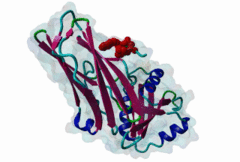| Accession: | |
|---|---|
| Functional site class: | AP2 alpha ligands |
| Functional site description: | Motifs responsible for the binding of accessory endocytic proteins to the alpha-subunit of adaptor protein AP-2 and their recruitment to the site of clathrin coated vesicle formation. |
| ELMs with same func. site: | LIG_AP2alpha_1 LIG_AP2alpha_2 |
| ELM Description: | The DPF/W motif binds the appendage of both alpha and beta subunits of AP2 adaptor complex (alpha2 and beta2 adaptin respectively). It is found on proteins involved in the control of clathrin coated vesicle (CCV) formation at sites of coated pits formation, allowing their recruitment to the site of CCV formation. Its binding site is a conserved patch on the platform subdomain of alpha2 and beta2 adaptins. Owen,2000 showed that if alpha and beta 2 adaptin share some ligands, they bind to them with different relative affinities. The difference in specificity is probably due to the different chemical properties of the residues surrounding the conserved binding site on the platform domain. For a given protein, the affinity of binding to alpha-adaptin appears to be correlated to the number of DPF/W motifs. Indeed Eps15, Epsin which contain several copies of the motif bind more tightly than amphiphysin, AP180 and auxilin which contain fewer copies (Owen,1999). |
| Pattern: | DP[FW] |
| Pattern Probability: | 0.0001192 |
| Present in taxon: | Eukaryota |
| Interaction Domain: |
Alpha_adaptin_C (PF02296)
Alpha adaptin AP2, C-terminal domain
(Stochiometry: 1 : 1)
|
Vesicular traffic in the endocytic and secretory pathway is mediated by vesicles that carry cargo proteins. Clathrin-coated vesicles are responsible for a large fraction of the vescicular traffic that reaches the endosomal compartment, originating from the plasma membrane or from the TGN (trans-Golgi network). The assembly of the clathrin-coated vesicles is mediated by proteic adaptors, monomeric as AP180 and CALM or multimeric complexes like AP (Adaptor Protein) complexes. AP complexes are heterotetrameric proteins that simultaneously interact with clathrin and endocytic proteins: for example, the beta-subunit of AP-2 complex binds to clathrin, the mu-subunit interacts with Y-based sorting signal present in the cytosolic tails of membrane receptors and the alpha-subunit of AP-2 binds regulatory/accessory proteins involved in the control of clathrin coated vesicle formation. |
(click table headers for sorting; Notes column: =Number of Switches, =Number of Interactions)
Please cite:
ELM-the Eukaryotic Linear Motif resource-2024 update.
(PMID:37962385)
ELM data can be downloaded & distributed for non-commercial use according to the ELM Software License Agreement
ELM data can be downloaded & distributed for non-commercial use according to the ELM Software License Agreement

